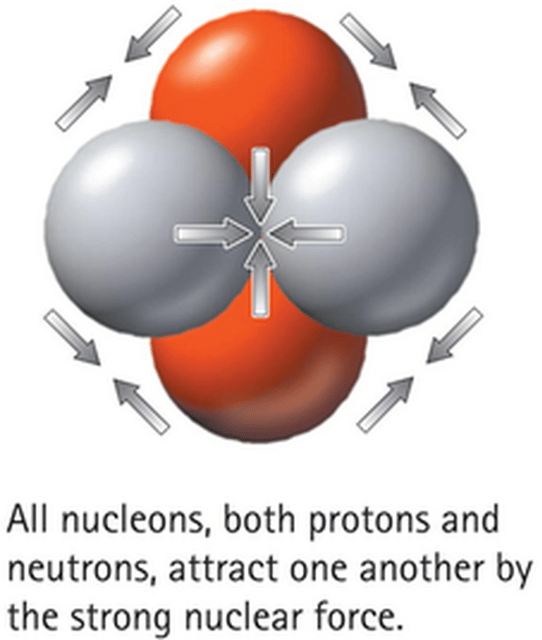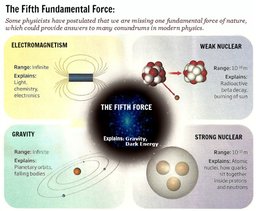Strong Nuclear Force

Strong Nuclear Force
Thestrong nuclear forceis one of four or five(see Fifth Force) fundamental forces in nature; the other three/four include gravity, electromagnetism, the weak force and dark photon force (see Fifth Force). As its name implies, the strong force is thestrongest force of the four. It is responsible forbinding together the fundamental particles of matterto form larger particles. [undefined]
The strong nuclear force is the nuclear binding force, providing attraction between a)protons and other protons, b)protons and neutrons, and c)neutrons and neutrons.
It keeps the nucleus of atoms together.
[undefined] A term frequently used in conjunction with atomic nuclei isnucleon. A nucleon is very simply a proton or neutron, especially when used with respect to an atomic nucleus. [undefined] [undefined]
The strong nuclear force also governs how quarks bind together into protons and neutrons and how these particles form atomic nuclei.
Four fundamental forces relative strengths comparison: [undefined] [undefined] [1]
| Force | Relative Strength | Exchange or Carrier Particle | Range(meters) |
| Gravity | 1 or 100 | Graviton | Infinity |
| Weak Nuclear Force | 1025 | W and Z Boson | 10-18or 0.1% of the diameter of a proton |
| Electromagnetism | 1036 | Photon | Infinity |
| Strong Nuclear Force | 1038 | Gluon, [Quark] | 10-15or diameter of medium sized nucleus |
As seen in the above table - gravity is the weakest force of the four, although its range is infinite.
The Strong Nuclear Force is strongest although its normal operating range is atomic or about 10-15meters.
The Coulomb force wherein 1) protons repel each other (same charges repel each other), 2) protons and electrons attract (opposite charges) and 3) electrons repel each other - is part of the electromagnetic force; electric charges can be zero(proton - electron), negative(electrons) or positive(protons). [1] [undefined]
Atomic nuclei store massive amounts energy inside them.
For example, element Helium normally has 2 protons and 2 neutrons in its nucleus = 4 nucleons.
μ or mu is frequently used to represent an atomic mass unit (basically, mass of atomic nuclei since electrons haverelativelynegligible mass). [undefined] Helium's total nuclear energy (2 neutrons, 2 protons,4.0026 amu) is about3,727.6 million electronVolts(MeV). Mass Difference
See also: Mass Difference, Gravitational Waves, Fifth Force, Dark Energy
Exhibits:
